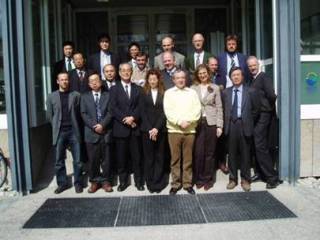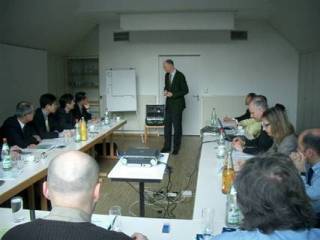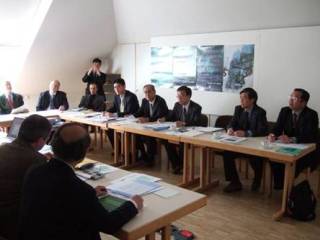Conference
-2006 Apr, Munich, Germany
| Name/Title | Interpraevent - Summit 2006 |
|---|---|
| Venue: Country,City | Munich, Germany |
| Date | From Apr 3 to 4, 2006 |
| Detail |
Haruo Nishimoto, Director for Volcanic Sabo and Debris Flow Control,
SABO Dept., MLIT Hideaki Mizuno, Senior Research Engineer, Erosion and Sediment Control. Division, National Institute for Land and Infrastructure. Management, MLIT. Joji Shima, Sabo Technical Center Interpraevent Summit 2006 was held on the 3rd and 4th of April of 2006, at the Bayern Environmental Agency in Munich, Germany. This Summit had been held once every four years; however, based on the agreement on the Summit on 2004 held in Riva Del Garda, Italy, it was decided to be held once every two years starting this year. The theme of this Summit was “Communication and co-operation in prevention of natural disasters and catastrophic events.” There were three sub-themes: 1) Variation and safety due to global warming, 2) Environment, tourism and safety, and 3) Lessons learnt from recent events. A total of 19 participants from seven countries and regions, namely, Japan, Aosta (Italy), Austria, Bavaria (Germany), Bozen/South Tyrol (Italy), Switzerland, and Trent (Italy), attended this Summit (See Picture - 1). Mr. Koji Kamee, Director General of SABO Dept., MLIT, and seven others participated from Japan.  Picture - 1: Summit 2006 Participants (Front row third person from the left: Director Koji Kamee, Front row third person from the right: Director Patek of Ministry of Agriculture, Austria) Presentations on the sub-themes by the representative of each country or region were conducted on the first day. Representatives from Aosta, Trent, Bozen/South Tyrol (All three from Italy), Bavaria (Germany) and Switzerland reported on the general outline and damage costs, and the efficacy of countermeasure construction and other themes related to the flood that occurred on the year 2000 and 2005 (Picture - 2). Austria conducted a presentation on the HORA, a type of Internet-based information delivery system, as an example of successful risk communication. Japan introduced the general outline of the damages, emergency rehabilitation, and permanent measures taken for the typhoon No. 14 in 2005 and the Mid Niigata Prefecture Earthquake in 2004. Reports on the general overview of the Sabo works and lessons learned from the disasters were also shared. Following the presentations of each country or region, a discussion was conducted on the education, dialogue with the residents, and responsibilities regarding natural disasters including sediment-related disasters. A consensus was reached on the necessity of conducting both structural and non-structural measures in a balanced manner. 
Picture - 2: Summit 2006 Scene of participants conducting presentations In addition, appropriate education towards the younger generation such as teaching children about the danger of natural disasters and the importance of disaster prevention countermeasures was agreed upon all participants to be a matter of great weight in order to further promote natural disaster prevention activities. Furthermore, the necessity of promoting awareness of the residents through activities such as creation of easy-to-understand pamphlets was also agreed. The morning of the second day started out with the continuation of the discussion from the previous day, followed by a summary of the whole conference (Picture - 3). As a result, from recent case examples of sediment-related disasters and floods, a common understanding was reached that emergency operations, which was already taken particular note at the Summit in 2004, and risk dialog with the residents were of utmost importance. To put these two points into practice, 1) Integrated approach and 2) Common awareness, preparedness, and responsibility were raised as feasible detailed measures.  Picture - 3 Summit 2006 Scene of participants having discussions The following were mentioned as being important to be aware of for 1) Integrated approach: Necessity of maintenance of structures created as countermeasures, considering lifesaving as the most important factor, necessity of a space (securement of land) to control the sediment and flood, and when formulating the disaster countermeasure plans, to include in the calculation the fact that the phenomenon could be more disastrous than what could be anticipated, among others. As for 2) Common awareness, preparedness, and responsibility, it was mentioned that the central government, local government and the local authorities need to take all measures possible to keep the risks to a minimum, but at the same time, these administrative organizations and the residents need to both be responsible in lowering the risks. To do so, it was agreed upon that the following was important: Conduct appropriate education towards the children, establish a specialized PR body, maintain a good relationship of dialogue with the residents who may be at risk of natural disasters, and give easy-to-understand and clear information to the residents, among others. The next summit is scheduled to be held in 2008 in Austria. Continuation of such conferences to promote global information exchange on the role of the government in preventing and reducing damages of sediment-related disasters is desired. |